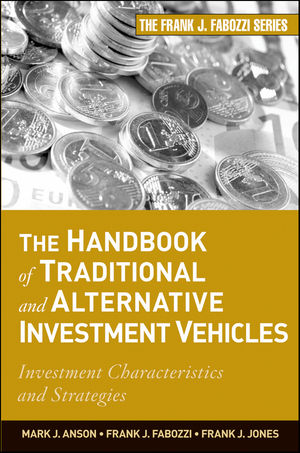The Handbook of Traditional and Alternative Investment Vehicles: Investment Characteristics and StrategiesISBN: 978-0-470-60973-6
Hardcover
530 pages
December 2010
 This is a Print-on-Demand title. It will be printed specifically to fill your order. Please allow an additional 10-15 days delivery time. The book is not returnable.
|
||||||
About the Authors.
CHAPTER 1: Introduction.
Risks Associated with Investing.
Asset Classes.
Super Asset Classes.
Strategic vs. Tactical Allocations.
Efficient vs. Inefficient Asset Classes.
Beta and Alpha Drivers.
Financial Instruments and Concepts Introduced in this Chapter.
CHAPTER 2: Investing in Common Stock.
Earnings.
Dividends.
Stock Repurchases.
The U.S. Equity Markets.
Trading Mechanics.
Trading Costs.
Financial Instruments and Concepts Introduced in this Chapter.
CHAPTER 3: More on Common Stock.
Pricing Efficiency of the Stock Market.
Stock Market Indicators.
Risk Factors.
Tracking Error.
Common Stock Investment Strategies.
Financial Instruments and Concepts Introduced in this Chapter.
CHAPTER 4: Bond Basics.
Features of Bonds.
Yield Measures and Their Limitations.
Interest Rate Risk.
Call and Prepayment Risk.
Credit Risk.
Financial Instruments and Concepts Introduced in this Chapter.
CHAPTER 5: U.S. Treasury and Federal Agency Securities.
Treasury Securities.
Federal Agency Securities.
Financial Instruments and Concepts Introduced in this Chapter.
CHAPTER 6: Municipal Securities.
Tax-Exempt and Taxable Municipal Securities.
Types of Municipal Securities.
Tax-Exempt Municipal Bond Yields.
Risks Associated with Investing in Municipal Bonds.
Build America Bonds.
Financial Instruments and Concepts Introduced in this Chapter.
CHAPTER 7: Corporate Fixed Income Securities.
Corporate Bonds.
Medium-Term Notes.
Commercial Paper.
Preferred Stock.
Convertible Security.
Financial Instruments and Concepts Introduced in this Chapter.
CHAPTER 8: Agency Mortgage Passthrough Securities.
Mortgages.
Mortgage Passthrough Securities.
Types of Agency Mortgage Passthrough Securities.
Prepayment Conventions and Cash Flows.
Factors Affecting Prepayment Behavior.
Prepayment Models.
Yield.
A Closer Look at Prepayment Risk.
Trading and Settlement Procedures for Agency Passthroughs.
Stripped Mortgage-Backed Securities.
Financial Instruments and Concepts Introduced in this Chapter.
CHAPTER 9: Agency Collateralized Mortgage Obligations.
The Basic Principle of CMOs.
Agency CMOs.
CMO Structures.
Yields.
Financial Instruments and Concepts Introduced in this Chapter.
CHAPTER 10: Structured Credit Products.
Private Label Residential MBS.
Commercial Mortgage-Backed Securities.
Nonmortgage Asset-Backed Securities.
Auto Loan-Backed Securities.
Collateralized Debt Obligations.
Financial Instruments and Concepts Introduced in this Chapter.
CHAPTER 11: Investment-Oriented Life Insurance.
Cash Value Life Insurance.
Stock and Mutual Insurance Companies.
General Account vs. Separate Account Products.
Overview of Cash Value Whole Life Insurance.
Taxability of Life Insurance.
Products.
Financial Instruments and Concepts Introduced in this Chapter.
CHAPTER 12: Investment Companies.
Types of Investment Companies.
Fund Sales Charges and Annual Operating Expenses.
Advantages of Investing in Mutual Funds.
Types of Funds by Investment Objective.
The Concept of a Family of Funds.
Taxation of Mutual Funds.
Structure of a Fund.
Financial Instruments and Concepts Introduced in this Chapter.
CHAPTER 13: Exchange-Traded Funds.
Review of Mutual Funds and Closed-End Funds.
Basics of Exchange-Traded Funds.
ETF Mechanics: The ETF Creation/Redemption Process.
ETF Sponsors.
Mutual Funds vs. ETFs: Relative Advantages.
Uses of ETFs.
The New Generation of Mutual Funds.
Financial Instruments and Concepts Introduced in this Chapter.
CHAPTER 14: Investing in Real Estate.
The Benefits of Real Estate Investing.
Real Estate Performance.
Real Estate Risk Profile.
Real Estate as Part of a Diversified Portfolio.
Core, Value-Added, and Opportunistic Real Estate.
Financial Instruments and Concepts Introduced in this Chapter.
CHAPTER 15: Investing in Real Estate Investment Trusts.
Advantages and Disadvantages of REITs.
Different Types of REITs.
REIT Rules.
Economics of REITs.
Financial Instruments and Concepts Introduced in this Chapter.
CHAPTER 16: Introduction to Hedge Funds.
Hedge Funds vs. Mutual Funds.
Growth of the Hedge Fund Industry.
Categories of Hedge Funds.
Hedge Fund Strategies.
Financial Instruments and Concepts Introduced in this Chapter.
CHAPTER 17: Considerations in Investing in Hedge Funds.
Hedge Fund Performance.
Is Hedge Fund Performance Persistent?
A Hedge Fund Investment Strategy.
Selecting a Hedge Fund Manager.
Financial Instruments and Concepts Introduced in this Chapter.
CHAPTER 18: Investing in Capital Venture Funds.
The Role of a Venture Capitalist.
The Business Plan.
Venture Capital Investment Vehicles.
The Life Cycle of a Venture Capital Fund.
Specialization within the Venture Capital Industry.
Stage of Financing.
Historical Performance.
Financial Instruments and Concepts Introduced in this Chapter.
CHAPTER 19: Investing in Leveraged Buyouts.
A Theoretical Example of a Leveraged Buyout.
How LBOs Create Value.
LBO Fund Structures.
Profile of an LBO Candidate.
Venture Capital vs. Leveraged Buyouts.
Risks of LBOs.
Financial Instruments and Concepts Introduced in this Chapter.
CHAPTER 20: Investing in Mezzanine Debt.
Overview of Mezzanine Debt.
Examples of Mezzanine Financing.
Mezzanine Funds.
Venture Capital and the Distinction Between Mezannine Financing and Different Forms of Private Equity.
Advantages of Mezzanine Debt to the Investor.
Advantages to the Company/Borrower.
Negotiations with Senior Creditors.
Market Performance.
Financial Instruments and Concepts Introduced in this Chapter.
CHAPTER 21: Investing in Distressed Debt.
Vulture Investors and Hedge Fund Managers.
Distressed Debt Is an Inefficient and Segmented Market.
Distressed Debt and Bankruptcy.
Distressed Debt Investment Strategies.
Risks of Distressed Debt Investing.
Market Performance.
Financial Instruments and Concepts Introduced in this Chapter.
CHAPTER 22: Investing in Commodities.
Gaining Exposure to Commodities.
Commodity Prices Compared to Financial Asset Prices.
Economic Rationale.
Commodity Futures Indexes.
Financial Instruments and Concepts Introduced in this Chapter.
APPENDIX A: Arithmetic Mean vs. Geometric Mean.
APPENDIX B: Measures of Risk.
Range and Location.
Moments of the Distribution.
INDEX.



